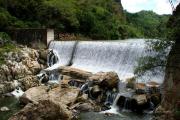The United Nations Educational, Scientific and Cultural Organization (UNESCO) seeks to encourage governments and people from across the globe to recognize and preserve places which show a deep cultural heritage by recognizing these places as World Heritage Sites. Here are ten heritage sites in the Philippines recognized by the UNESCO World Heritage Centre:
Tubbataha Reef National Marine Park
Covering 130,028 ha, including the North and South Reefs, Tubbataha Reef is an atoll coral reef that can be found 98 nautical miles southeast of Puerto Princesa City, Palawan. Due to its biodiversity, it was named a World Heritage Site by the United Nations Educational Scientific and Cultural Organization (UNESCO) in 1993.
The 33,200-hectare Tubbataha Reef National Marine Park is home to hundreds of species of marine life and serves as a nesting place for birds and marine turtles. The site is an excellent example of a pristine coral reef with a spectacular 100-m perpendicular wall, extensive lagoons and two coral islands.
The Banaue Rice Terraces is a product of almost two millennia of Ifugao agricultural engineering. In the past, the marvelous place was also known as the “Eighth Wonder of The World.” It was proclaimed as a UNESCO World Heritage Site in 1993, and cited as the “priceless contribution of Philippine ancestors to humanity.”
For 2,000 years, the high rice fields of the Ifugao have followed the contours of the mountains. The fruit of knowledge handed down from one generation to the next, and the expression of sacred traditions and a delicate social balance, they have helped to create a landscape of great beauty that expresses the harmony between humankind and the environment.
Puerto Princesa Subterranean River National Park
In 1999, the Puerto Princesa Subterranean River National Park was declared a UNESCO World Heritage Site. It is found about 50 kilometers from Palawan’s capital city, Puerto Princesa. The Subterranean Park is known to be the world's longest navigable underground river, which also displays a spectacular limestone karst landscape. The place is a significant habitat for biodiversity conservation with a full mountain protecting the forests and the sea ecosystem.
One of the river's distinguishing features is that it emerges directly into the sea, and its lower portion is subject to tidal influences. The site contains a full mountain-to-sea ecosystem and has some of the most important forests in Asia.
The city of Vigan was named a UNESCO World Heritage Site in 1999, due mostly to the fact that the place has been carefully preserved to show the fusion of old Asian and Spanish architecture. Its architecture reflects the coming together of cultural elements from elsewhere in the Philippines, from China and from Europe, resulting in a culture and townscape that have no parallel anywhere in East and South-East Asia.
At present, the famous cobblestoned street of Calle Crisologo is conserved by the local government by prohibiting any motor vehicle to travel along the road.
Apo Reef National Park, found in Sablayan, Mindoro Occidental, showcases the second largest contiguous coral reef in the world and the second largest in the Philippines. Apo Reef is the largest of the three islands that make up the park; the other two islands are Apo Island and Pandan Island. It became part of the UNESCO World Heritage Site’s tentative list when it was submitted in 2006.
Mount Iglit-Baco National Park
The Mount Iglit-Baco National Park is the only known habitat of the Philippine tamaraw. It was proclaimed as a national park by virtue of R.A. 6148 dated 11 November 1970. The park is a protected area on Mindoro island and was submitted to the UNESCO World Heritage Site’s tentative list in 2006.
Baroque Churches of the Philippines
These four churches, the first of which was built by the Spanish in the late 16th century, are located in Manila, Santa Maria, Paoay and Miag-ao. Their unique architectural style is a reinterpretation of European Baroque by Chinese and Philippine craftsmen.
The Church of San Agustin, also known as Paoay Church, was built by Augustinian friars in 1694 and was finished only after 200 years. It reflects a unique combination of Gothic, Baroque, and Oriental architecture. The ancient church was declared by former president Ferdinand Marcos as a national treasure, and subsequently became part of the group of four baroque churches recognized as World Heritage Sites by the UNESCO World Heritage Centre.
The Santo Tomas de Villanueva Church was built in 1797 by the Augustinian Missionaries in Miag-ao, Iloilo. It was specifically designed to serve as a fortress to protect the people from the Muslims (‘’Moros’’) who invaded Christianized villages during the early times. The church is one of the four baroque Philippine churches recognized by the UNESCO World Heritage Centre in 1993.
‘’Nuestra Señora de la Asuncion’’ or the Church of the Assumption was built on top of a hill in Santa Maria, Ilocos Sur and can be reached by climbing a flight of 82 steps. The church has a red façade with exposed brickwork. It was declared a National Historical Landmark on 26 September 1982. On 11 December 1993, it was declared as a World Heritage Site by the UNESCO along with three other baroque churches spread throughout the Philippines.
The San Agustin Church is the oldest existing church in the Philippines. It lies inside the walled city of Intramuros in Manila. Together with three other baroque churches, it was recognized in 1993 as one of the four Baroque Churches of the Philippines which were declared World Heritage Sites by the UNESCO World Heritage Centre. The legacies of the Spanish ‘’conquistadores’’ Miguel López de Legazpi, Juan de Salcedo, and Martín de Goiti are kept in the church.










